|
|
|||||||||||
|
|
|||||||||||
 |
|||||||||||
|
|
|||||||||||
|
![]()
| Interview with Mr. Di Guoyong, Xingyiquan expert from Beijing and president of the Beijing Xingyiquan Research Association |
|
by Jarek Szymanski Photos - courtesy of Mr. Di Guoyong, all translations and notes by J. Szymanski © J.Szymanski 2003-2004 |
| CONTINUATION FROM THE PREVIOUS PAGE : |
|
JS: Please tell us more about theory of Xingyiquan. MR. DI: Large number of texts on theory of Xingyiquan published in first decades of twentieth century use many terms borrowed from Taoist classics. I made a comparison of the terms and their relation to the "Three Steps of Skill" (San Bu Gongfu), the most important theory in Xingyiquan: |
|
THREE STEPS OF DEVELOPMENT IN XINGYIQUAN |
|||
| Obvious Power | Hidden Power | Neutralizing Power | |
| (Ming Jin) | (An Jin) | (Hua Jin) | |
| Principles of Three Stages (San Ceng Daoli) | Transforming Vitality into Qi (Lian Jing Hua Qi) | Transforming Qi into Spirit (Lian Qi Hua Shen) | Transforming Spirit and Returning to Emptiness (Lian Shen Huan Xu) |
| Kind of Power | Whole-body Power (Zheng Jin) | Internal Power (Nei Jin) | Soft Neutralizing (Rou Hua) |
| Power Seen From the Perspective of the Target of Attack | Explosive Power (Bao Fa Jin) | Penetrating Power (Tou Jin) | Sticky Power (Nian Jin) |
| Relation Between Basics and Internal Practice | Focus on Basics and Techniques (Ji Fa) | Techniques and Internal Practice (Nei Gong) Equally Important | Primary Focus on Internal Practice, Secondary on Techniques |
| Changes | Change of Power (Huan Jin) | Change of Physique (Tizhi) | Change of Disposition (Qizhi) |
| Tempering | Body | Willpower | Mentality |
| Capability | Training one's own physical strength | Training the instincts | Exploiting potentialities |
| Direction of Practice | From the Outside Training the Inside | From the Inside Training the Outside | No Inside No Outside |
| Power is related to | Practicing the Form (Xing) | Practicing The Intent (Yi) | Practicing the Spirit (Shen) |
| Stage Formed in Cerebrum Through Movements | Following Patterns | Analyzing | Automatic |
| Level Of Consciousness in Controlling Movements | Consciousness | Low Consciousness | Subconsciousness |
| Speed of Movements | Fast | Slow | Fast and Slow are alike |
| Expression of Three Internal Harmonies | Strength and Qi Combine (Li Yu Qi He) | Qi and Intent Combine (Qi Yu Yi He) | Intent and Spirit Combine (Yi Yu Shen He) |
| Growth and Decline of Strength | Eliminating "Clumsy" Strength (Zhuo Li) | Eliminating Hard Power (Gang Jin) | Strengthening Softness and Effectiveness of Neutralizing |
| Expression of Power | Hard, Sudden and Vigorous (Gang Meng) | Soft and Following (Rou Shun) | Coupling Hardness with Softness (Gang Rou Xiang Ji) |
| Following the Requirements | Strictly Following the Requirements | Mutually Conforming with Requirements | Naturally Conforming with Requirements |
| Postures | First Open and Wide | Then Compact | Pursuing Round and Full |
| Goal in Power Practice | Pursuing Hardness Through Combining the Power of All Parts of the Body | Pursuing Softness Through Relaxation and Mobility | Pursuing Excellence Through Agility and Skill |
| Practice of Speed | Pursuing Integrity (of the Whole Body) Through Fast Practice | Pursuing Length (Stretching Tentons) Through Slow Practice | Changing Speed with Facility |
| Expression of Movements | Rising and Falling in Order, Simultaneously (Qi Luo Zheng Qi) | Power is Round and Intent is Distant (Jin Yuan Yi Yuan) | Spirit and Intent Permeate (Shen Yi Guan Tong) |
| Applications | Stress on Attack | Stress on Restraining | Stress on Redirecting and Neutralizing |
| Sound of Feet Touching the Ground | With Sound | Without Sound | Sudden Clap of Thunder While in Silence |
| Power is expressed in | Hands | Elbows | Body |
| Coordinating Qi and Dantian During Power Release | Qi Sinks in Dantian | Qi Gathers in Dantian | Qi Moves in Dantian |
| Coordinating Qi and Intent (Yi) | Qi Hastens Strength (Yi Qi Cui Li) | Guiding Qi with Intent (Yi Yi Dao Qi) | No Intent no Qi (Wu Yi Wu Qi) |
| Use of Qi | Guiding Qi with Strength (Yi Li Dao Qi) | Nourishing Spirit with Qi (Yi Qi Yang Shen) | Driving Qi with Spirit (Yi Shen Yu Qi) |
| Training Dantian | Lower Dantian | Middle Dantian | Upper Dantian |
| Expression of Breathing | Expressed Externally (Adjusting Breathing) | Expressed Internally (Adjusting Breathing so that Breathing In Is Long) | Exists Without Any Appearance - Fetal Breathing (Tai Xi) |
| Length of Breathing In and Out | Long Breath In Short Breath Out, Very Brief and Powerful | Long Breath In and Long Breath Out, Soft Becoming Delicate, Extending the Short and Causing It to Become Long | Length of Breath In and Out At Will, Continuous, Delicate and Even, Deep and Long |
| Requirements for Breathing | Adjusting Stage | Coordinating Stage | Stage of Natural Harmony |
| Focus of Practice | Shape (Xing) | Intent (Yi) | No Shape No Intent (Wu Xing Wu Yi) |
| The above comparison was made by Mr Di Guoyong. Click here to read classical texts concerning the theory of Hebei Xingyiquan. | |||
|
JS: What do you think about the relationship between Xingyiquan and Traditional Chinese Medicine (TCM)? MR. DI: It is said that Five Internal Organs (Wu Zang, Heart, Liver, Spleen, Lungs and Kidneys) are directly related to Five Elements Fists (Wu Xing Quan). However what is the exact relation? It is very difficult question to answer. Five Elements Fists are related to Metal, Wood, Water, Fire and Earth (Five Elements, Wu Xing). In TCM five internal organs are also related to Five Elements. TCM uses Yin/Yang and Five Elements as the guiding principles for its theory. Interactions, mutual promotion and restraint between Five Elements, their changes form the basics of TCM. Why does Xingyiquan - martial art created for practical combat - use TCM theory and terms? This is because as long as you want to be efficient in fighting, be able to use the art for martial purposes, you must be in good health. That's why Xingyiquan introduced Five Elements theory from TCM. Some claim there is no relation between Five Elements Fists of Xingyiquan and Five Elements theory of TCM. However in order to understand the relation it is important not to confuse Five Internal Organs of TCM with organs defined by anatomy of western medicine. TCM's organs are in fact whole systems and physiological functions of the body, and not certain parts of the body. |
|
|
|
Why did old masters linked Five (Elements) Fists with Five Internal Organs (as we can now read in old boxing manuals)? The reason was to "make the inside (internal organs) healthy and strengthen the outside (the body)". However the relation between Five Elements Fists and Five Elements of TCM cannot be understood by beginner. It is like explaining advanced mathematical theories to elementary school student. One has to reach a high level in Five Elements Fists practice to be able to "experience" the relation. Internal organs are governed by autonomous nervous system. Movements of your body can be easily controlled by your mind. However you cannot control the beat of your heart or breathing. On the other hand Qigong allows you to control these functions to some degree. In the same way in martial arts, once a high level of skill is achieved, it also allows the practitioner to have certain influence on these functions. Hence through martial arts practice involuntary movement gradually becomes voluntary. This of course does not mean that if you want to stop action of your heart, it will stop beating. It is rather a matter of having some mental control over these functions so that they can be improved. That's why we say that Chopping Fist (Pi Quan) trains Lungs, Drilling Fist (Zuan Quan) trains Kidneys, Crushing Fist (Beng Quan) trains Liver, Cannon Fist (Pao Quan) trains Heart and Horizontal Fist (Heng Quan) trains Spleen. I believe the relation is rather a connection of channels (Jingluo, network of passages through which vital energy circulates) with nervous system, intent. |
|
Tiger Form (Hu Xing) - Downward Push (Tuo) |
|
|
Chinese martial arts also share another
feature with TCM - both systems are based on learning through one's personal
experience. If you do not have this personal experience, if you have not reached
certain level of skill, you will not be able to understand what the old boxing
manuals talk about. Although you can say that you understand the words of old
masters, but if you do not have the personal experience, this theoretical
knowledge is worth nothing. This is the main feature of ancient Chinese culture
and knowledge. Concerning the relation between Five Elements Fists and TCM - I would like to conduct scientific research to analyze Five Elements Fists from the point of view of modern physiology. The plan is to do it together with Beijing Physical Education University. I already made a preliminary preparations, and while I have certain experience, I would like to undergo a series of tests to obtain scientific data. After my first book is published, I would like to include these data in the second book - "The Sports Physiology of Five Elements Fists of Xingyiquan". JS: Your set of VCDs on Xingyiquan has been considered one of the best instructional video materials released in China. Will the first book cover the material already available on VCDs? MR. DI: The book will include chapters on Standing Methods (Zhuang Gong) of Xingyiquan, Five Elements Fists, Five Elements Linked Fists (Wu Xing Lian Huan Quan), Twelve (Animal) Shapes (Shi Er Xing), Mixed Strikes (Za Shi), Eight Postures (Ba Shi), Twelve Powerful Strikes (Shi Er Hong Chui) and Eight Characters Method (Ba Zi Gong). JS: Will the applications for the movements be described in the book? Many martial arts practitioners are looking not only for descriptions of movements, but also for their practical applications. MR. DI: Yes, the book will cover the applications as well, of both empty hand routines and sets with weapons. The movement will be described in detail, then its essentials, specific powers, methods of teaching and practice, most common mistakes and how to correct them, combat applications (in attack and defense), intention of the movement and principles of how to use it in fighting. This method of presentation I applied to both empty hand and weapons techniques. JS: Talking about weapons - what weapons are traditionally practiced within Xingyi system? Which weapons were present in old Xingyi and which were incorporated into the system later? |
|
|
Xingyi Spear (Qiang) - the weapon Xingyi system was based on |
||
|
|
|
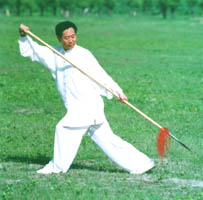 |
| Thrusting Forward (Zha) | Lifting (Ti), also called Cannon Spear (Pao Qiang) | Looking Back Spear (Hui Tou Qiang) |
|
MR. DI: From the point of view of the old Xingyi boxing manuals, it is said that "weapons are extensions of the body". This means the weapons should be used with the same power of the body as empty hand techniques. However each weapon has its own unique shape and hence unique method of using it. Spear, stick, broadsword, sword - they are all different so of course they will be used differently. However the power (Jin Li) driving them will be Xingyi power; footwork, mindset, movements will all be characteristic to Xingyi. Old generation masters used to say that "three best weapon systems were: spear of Xingyi, broadsword of Bagua and sword of Taiji". Xingyi is said to be created on the basis of spear techniques, so I believe that Xingyi practitioners should practice with long spear. Exercises with spear develop power, so that the whole body power can be transferred onto the spear. Shang Yunxiang was famous for his long pole (Da Ganzi) which he used to develop power. JS: But why is that there are so many weapons in Xingyi? Broadsword, Spear, Sword, Stick and many others? MR. DI: One teacher studied Xingyiquan, but liked stick techniques very much. He learnt the stick somewhere else and put Xingyi methods into the stick movements in this way creating Xingyi stick. Another teacher liked sword and put Xingyi methods into the sword movements that he learnt elsewhere thus creating Xingyi sword set. JS: Which weapons that can be found in Xingyi only and do not appear in other styles? MR. DI: The best example would be Unicorn's Saber (Lin Jiao Dao). Song Shirong's system is famous for this weapon, but it was also practiced by Shang Yunxiang. Other weapons however are shared by other systems as well - these are Broadsword, Spear, Sword, Stick that I have already mentioned. JS: What about Iron Chopsticks (Tie Kuaizi) that can be found in Wang Jiwu's style of Xingyi? MR. DI: This weapon was introduced to Xingyi system later and the routine was compiled later as well. This takes us back to what was already said - "weapons are extensions of the body". Old masters can take chopsticks and use them for fighting, or take a walking stick and use it as well - and it will always be Xingyi power that they have developed through lifelong practice of Xingyiquan. Xingyi weapons are performed in different way than in other styles. There are no flowery movements, all techniques are rather simple and useful. They are not beautiful, but once Xingyi power is developed and expressed through weapons movements, they can be considered beautiful. JS: What do you think about relations between Xingyiquan and other internal martial arts like Taijiquan and Baguazhang? MR. DI: Since Xingyiquan was created and has been growing up in this "garden of martial arts", it must have of course absorbed a lot of different nutriments. I think there are many styles among Chinese martial arts that share similar or identical parts. However these parts are expressed differently - the general manner, the powers and the guiding theories, principles are different. JS: Some say that one should first start his internal boxing practice from Xingyi, then learn Bagua, and finally Taijiquan, which is considered the most advanced martial art... |
| Xingyi Stick (Gun) |
MR. DI: There is some truth in this statement. However I consider the claim that Xingyi stresses hardness, while Taiji stresses softness as one-sided view. Xingyiquan strives for balance between hardness and softness (Gang Rou Xiang Ji); Taijiquan is not only about softness, it also combines hardness with softness. When power is used in Taijiquan, it is also hard, complete power of whole body. Hence saying that Xingyi stresses hardness, while Taiji - softness - only shows that one sees only the external expression of the art and does not look deeper, where it becomes clear that it is also about balancing hardness with softness. However if one wants to develop "coordinated power of the whole body" (Zheng Jin) in short time, Xingyi is the best choice. Why? Because in the beginning the practice in Xingyi is based on hard power, it's standarized. Then it is easier to "melt" hard power into soft one without loosing the whole body coordination. Besides Xingyi stresses practicing a limited set of movements to perfection (Shao Er Jing). Five Elements Fists (Wu Xing Quan) should not be considered fighting methods (Ji Fa), but power methods (Jin Fa). For example the practice of Chopping Fist (Pi Quan) is very standardized, however in fighting, no matter whether I use palm, fist or elbow, if only the direction of power is from up downwards and forward, they all belong to Chopping Fist. Or Crushing Fist (Beng Quan) - if only I can strike along a straight line, connecting one point with another, it is all Beng Quan, no matter if it is performed higher or lower; Zuan Quan (Drilling Fist) is the same - your movement has to contain the drilling component to make it Zuan Quan. Wu Xing are five different methods of using power, not just certain techniques; it is up to you what part of the body you use in fighting when issuing one of these powers and how you combine them. Another advantage of Xingyiquan is its imposing, aggressive manner (Qi Shi). This is because of the theory Xingyiquan uses - "treat the opponent as a straw of a weed" (Shi Ren Ru Hao Cao), "Rise like a wind, fall like an arrow, be unhappy with your speed although you have already knocked out the opponent" (Qi Ru Feng Luo Ru Jian Da Dao Hai Xian Man), "defeating the opponent is like snake sucking the food in" (Sheng Ren Ru She Xi Shi). This theory instructs the practitioner in Xingyi mentality. Old Xingyi manuals say "When you meet the enemy it's like a fire burning your body" (Yu Di Hao Shi Huo Shao Shen) - I believe all these sentences talk about the mentality, fighting spirit, what we would call nowadays "fighting intent", or - in other words - first degree of combat readiness (Yi Ji Zhan Bei). This is the mindset one should always keep when practicing Xingyiquan. |
|
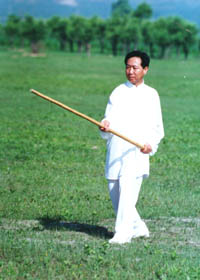 |
||
| Chopping Stick (Pi Gun) | ||
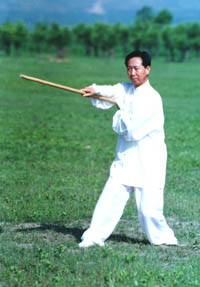 |
||
| Horizontal Stick (Heng Gun) | ||
|
JS: These ideas seem very similar to what Yi Quan (Intention Boxing) looks for... MR. DI: I think many principles of Yi Quan did not go beyond the theory of Xingyiquan. Actually Xingyiquan was also originally called Yi Quan. While Yi Quan changed and developed its own specific practice methods, its theory is basically identical with that of Xingyiquan. By the way in old boxing manuals Five Elements are called Yi Quan - Intent Boxing, while Twelve (Animal) Shapes - Xing Quan (Animal Shape Boxing), hence the whole name of the style - Xing Yi Quan. JS: You mentioned that Five Elements teach five basic powers. What are then the Twelve Shapes (Shi Er Xing) for? |
|
|
MR. DI: One reason is to study (Animal) Shapes Fists (Xing Quan), traditional sets of movements. The other reason is to make up for some deficiencies of Five Elements Fists. For example in Snake Shape (She Xing) one learns Lifting Power (Tiao Jin, upward power), which can't be found in Five Elements. In Tuo Shape one learns horizontal power which also does not appear in Five Elements. Besides Twelve Shapes teach many new techniques, applications - footwork, kicks, hand techniques. Then there is also Eight Characters Method (Ba Zi Gong)... JS: What is Eight Characters Method? MR. DI: Eight Characters are: Zhan (Opening), Jie (Intercepting), Guo (Wrapping), Kua (Collapsing), Tiao (Lifting), Ding (Propping), Yun (Waving), Ling (Leading). From the powers point of view Ba Zi Gong also compensates the deficiencies of Five Elements and Twelve Shapes. I believe each of these parts of Xingyiquan arsenal was created in the process of perfecting the art. For example Guo (Wrapping) does not exist either in Wu Xing or Shi Er Xing, it is a wrapping movement inwards. By the way my Ba Zi Gong is different from the one that was described by Jiang Rong Qiao. For example Jiang says Zhan means "Slaying" and it is just Chopping Fist (Pi Quan), while in my branch Zhan means "Opening up", "Spreading out" and means spreading both arms outwards. |
|
Opening Up (Zhan Character Method) |
|
| JS: Could you tell
us a bit about Three Old Fists (Lao San Quan)? MR. DI: Three Old Fists are Zuan (Drilling), Guo (Wrapping) and Jian (Stepping Forward). I think they are Pi (Chopping), Zuan (Drilling) and Beng (Crushing). If we analyze Five Elements Fists, it is easy to find out that Pao Quan (Cannon Fist) is actually Beng Quan (Crushing Fist) with additional movement of other hand; Heng Quan (Horizontal Fist) is very much like Zuan (Drilling). For this reason I think the Three Old Fists should be Pi - Zuan - Beng. These are the simplest, fastest techniques of Xingyi. Pao Quan (Cannon Fist), although similar to Beng Quan (Crushing Fist), stresses the twisting movement of the waist, which is not so obvious in Beng. Heng Quan (Horizontal Fist) can be performed in many different ways including Nei Heng (inward Heng), Shun Bu Heng (Heng with corresponding step, i.e. performed with right hand if right leg is in front or left hand if the left leg is in front), Ao Bu Heng (Heng with reversed step, i.e. performed with right hand when left leg is in front and vice versa), Shuang Heng (Double Heng performed with both hands) and many others that add special characteristics to Horizontal Fist. |
|
|
Xingyi Sword (Jian) | Xingyi Broadsword (Dao) | |
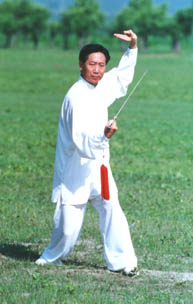 |
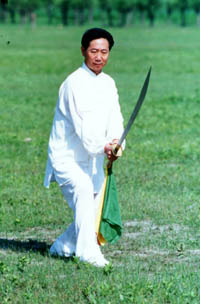 |
||
| Drilling Sword (Zuan Jian) | Chopping Broadsword (Pi Dao) |
|
This is because of different dialects spoken in both provinces and the fact that most martial arts practitioners were not educated. Concerning "Za Shi Chui" - my opinion is that character "Za" "Mixed" should be used in the name of the routine - because the set is composed of various movements coming from Twelve Shapes - Swallow, Chicken, Sparrow Hawk, Horse as well as other techniques that can be found neither in Wu Xing nor Shi'Er'Xing. When explaining "Zha" - "Floodgate" Shanxi practitioners say that the practice of this set is like floodwaters breaking through a dam. Why do we use character "An" - "Calm" in the matched set of "An Shen Pao"? Because frequent practice of this set will develop power and speed of the practitioner and thus will ensure his safety. In Shanxi it is called "Ai Shen Pao" - "Cannon close to the Body" because both practitioners are very close to each other when practicing the set. I disagree with the latter explanation because in old boxing manuals character "An" - "Safe" is used. JS: Mr. Di, thank you very much for sharing your knowledge with us! |
| "THREE STEPS OF SKILL" (SAN BU GONGFU) |
|
The idea of "Three Steps of Skill" (San Bu Gongfu) as well as of "Principles of Three Stages" (San Ceng Daoli) and "Three Methods of Practice" (San Zhong Lianfa) are attributed to Guo Yunshen (1820-1901), native of Shen County in Hebei Province. Guo was on of best disciples of Li "Divine Fist" Laoneng, and was famous for his Half-step Crushing Fist. Guo Yunshen was the most important Xingyiquan expert of his times and had deep influence on the whole generation of teachers. Guo's ideas and theories were widely accepted in Hebei and the most famous branch of Xingyi - Hebei (Province) Xingyiquan - took shape and developed under Guo's influence. However the branches in neighboring Shanxi Province developed independently of Hebei ones and the theory of "Three Steps of Skill" is often rejected by them. Many of Che Yizhai's inheritors state that they practice three powers - Obvious, Hidden and Neutralizing - simultaneously, not separately. On the other hand "Three Steps of Skill" have many similarities with the idea of "Heavy Movement - Light Movement - Agile Movement" (Zhong Dong - Qing Dong - Ling Dong) of Dai Family Xinyiquan. Following text is attributed to Guo Yunshen and was published in Sun Lutang's "The True Essence of Boxing" in 1924: "Principles of Three Stages (San Ceng Daoli) Transforming Vitality into Qi (Lian Jing Hua Qi), Transforming Qi into Spirit (Lian Qi Hua Shen), Transforming Spirit and Returning to Emptiness (Lian Shen Huan Xu). It is practiced to change one's disposition (Qizhi), to restore one's original True (nature). Explanation: (whole above paragraph) Mr. Li Dongyuan said: "Human being gives birth to Spirit (Shen) from Emptiness and Nothingness (Xu Wu), collects Spirit and gives birth to Qi, collects Qi and gives birth to Vitality (Jing), this is (the process) from Nothingness (Wu) to Existence (You). (While) Transforming Vitality into Qi (Lian Jing Hua Qi), Transforming Qi into Spirit (Lian Qi Hua Shen), Transforming Spirit and Returning to Emptiness (Lian Shen Huan Xu) is (the process) from Existence (You) to Nothingness (Wu). This is exactly the Way (Dao) of martial art, the principle of creating and transforming! Three Steps of Skill (San Bu Gongfu) Changing Bones (Yi Gu), it is practiced to solidify one's base, strengthen the body; the substance of bones becomes solid as iron, while shape, postures and disposition powerful and strong like Mount Tai. Changing Sinews (Yi Jin), it is practiced to develop fascia (Mo), to lengthen the sinews; as popular saying goes: "(when) the sinews are long, the strength is great", their strength is crisscrossed, connected and grows without limits. Changing Marrow (Yi Sui), it is practiced to purify one's inside, to relax one's body and make it light, (so there is) appearance of purity and emptiness, Spirit (Shen) and Qi are used smoothly and without obstruction, (it is achieved) only when the body in movement is light like a feather. Explanation: (the paragraph starting with Changing Marrow) It says that when practicing martial art, the inside should be empty, the body should be naturally relaxed and soft, the activity of Spirit and Qi and movements of the body should be flexible, smooth and without obstruction. Boxing classics say "Three Cycles and Nine Twists are One Form", "Three Cycles" are: Transforming Vitality into Qi (Lian Jing Hua Qi), Transforming Qi into Spirit (Lian Qi Hua Shen), Transforming Spirit and Returning to Emptiness (Lian Shen Huan Xu), i.e. Obvious Power, Hidden Power and Neutralizing Power. "Three Cycles" - Obvious, Hidden and Neutralizing Powers - are one form. "Nine Twists" refers to Pure Yang (primordial state). Once the transformation reaches Emptiness and Nothingness, then (one) returns to Pure Yang. Three Methods of Practice" (San Zhong Lianfa) Obvious Power (Ming Jin), the main principle is to practice it (strictly) according to the requirements that must not be changed, the movement of the body must be smooth and harmonious and must not be disharmonious, hands and feet must fall in order simultaneously and not in disorder. This is exactly the meaning of what the boxing manual says: "Square is to correct the center". Explanation: "Square" refers to a method, Way. Only by following this method one can exactly conform with the requirements, and only then the hands and feet will Rise and Fall (Qi Luo) in order simultaneously. Hidden Power (An Jin), (when) practicing it Spirit and Qi should be relaxed and smooth, and must not be restrained, applied in a round, flexible way, without obstruction. This is exactly the meaning of what the boxing manual says: "Round is to respond to the outside". Explanation: "Round" refers to complete, well-developed object, perfectly round means that the rim of the circle has no imperfections, when practicing the martial art, Spirit and Qi should be relaxed and smooth, applied in a round, flexible way, without obstruction. Observing the external form, it resembles an endless, round, circular movement. Neutralizing Power (Hua Jin), (when) practicing it, moving the whole body, Rising and Falling (Qi Luo), Advancing and Retreating (Jin Tui), one must not use any strength, but focus on handling them with Spirit (Shen) and Intent (Yi). While (only) Spirit and Intent are used, however the shape, postures must follow the rules as in above two (methods; e.g. the same as for practice of Obvious and Hidden Powers) and must not be changed. Although no force should be used when moving the body, however it is not that completely no force is used, generally (speaking) Mind (Xin) and Intent (Yi) (should) permeate (all movements). This is also the meaning of what the boxing manual says: "Three Cycles and Nine Twists are One Form". [from: "The True Essence of Boxing" by Sun Lutang, 1924, translated by J.Szymanski] |
| Instructional sets of ten VCDs/DVDs on (Hebei) Xingyiquan by Mr. Di Guoyong are available through this website: | ||||
| Price:
VCDs: US$88.00
(including Shipping by Airmail) for the whole set of ten discs (or US$9.00 for
one disc without Sh&H) DETAILS
|
||||
| DVDs (with subtitles in English): US$128.00
(including Shipping by Airmail) for the whole set of ten discs (or US$13.50 for
one disc without Sh&H)
DETAILS
|
||||
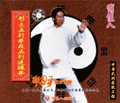 |
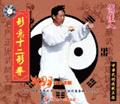 |
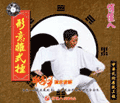 |
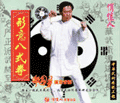 |
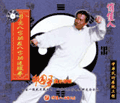 |
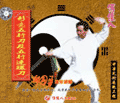 |
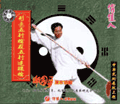 |
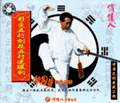 |
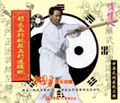 |
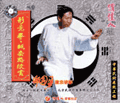 |
| The set covers: Five Elements Fists, Five Elements Fists Linked Routine, Five Elements Cannon (Matched) Routine, Twelve (Animal) Shapes, Mixed Strikes Routine, Eight Postures Routine, Safe Body Cannon (Matched) Routine, Eight Characters Method, weapons: Broadsword, Spear, Sword and Stick (each weapon includes basics techniques - Five Elements - and linked routine), demonstrations of routines... | ||||
| CLICK TO ORDER! | ||||
End of "Interview with Mr. Di Guoyong, Xingyiquan expert from Beijing and president of the Beijing Xingyiquan Research Association"; © J.Szymanski 2003-2004 |
Home ▪ About me ▪ Updates ▪ Taiji ▪ Bagua ▪ Xinyi-Xingyi ▪ Other Styles ▪ News ▪ Store ▪ Community ▪ Email